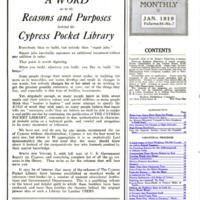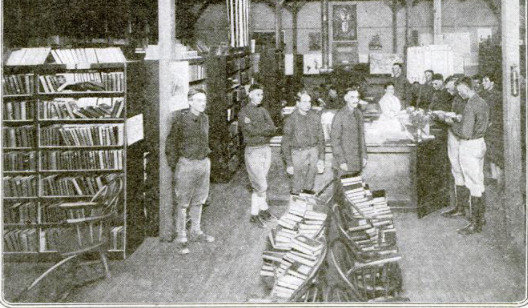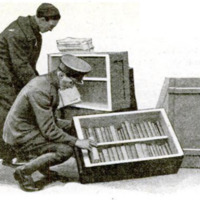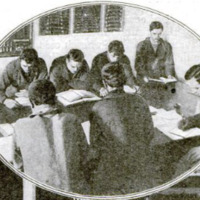-
Title (Dublin Core)
-
The importance of the Library War Service for U. S. soldiers training
-
Article Title and/or Image Caption (Dublin Core)
-
Title: Minds as Sharp as Bayonets
-
Subtitle: How the Library War Service provides for the education of our fighting men
-
extracted text (Extract Text)
-
THE complexities and constantly
changing character of the war,
and the necessity for the rapid
training of specialists in every branch
of service, created an emergency in
the matter of supplying text-books.
Many subjects developed so fast that
print could not keep up with them—
for instance, aerial photography and
camouflage. Army liaison, never be-
fore employed on so large a scale, had
been written of scarcely at all.
The Library War Service of the
American Library Association engaged
to furnish any published technical
work or text-book that might be
needed in army camps, war schools
and colleges, or naval establishments,
in this country or overseas. It could
not very well furnish bools that have
never been written, but it could do
the next best thing. It could furnish
the technical and scientific data
from which such text-books
might be compiled. If, for in-
stance, the latest work on camou-
flage were hopelessly out of date,
the Association would get to-
gether all of the available books
on animal protective coloring
and color-photogra-
phy. From reference
books of similar value
the army experts pre-
pared their own text-
books in mimeo-
graphed form.
Arts of Peace Applied
to War
Many of these ar-
my text-books con-
cerned the adaptation
of familiar arts to
army uses. A book
on motoreyeles that
was prepared at Camp
Joseph E. Johnston,
Florida, included a
complete manual of
instruction for
the convenience of
despatch riders, with
very complete chap-
ters on the personnel,
equipment, and or-
ganization of motorcycle companies in
the field.
In a whole library on the subject of
printing there exists no book especially
designed to fit the needs of army
printers.
War and the army have a nomen-
clature all their own, with scores
of abbreviations unfamiliar to civil
workers. An army print-shop is dif-
ferent from an ordinary composing-
room. The printer had to learn the
etiquette of war. He had to know,
for example, exactly in what type to
set a general order, and by whose
authority an officer may have his name
and telephone number on a letter-head.
‘When the libraries were first planned,
it was thought they would be used
chiefly for recreation. It was found
that the most regular readers used
them for study purposes. This meant
a rapid reorganization of the book
collections, involving the purchase of
600,000 technical and military books.
Gift books to the number of
2,600,000 volumes, the donations of
the public—largely in the classes of
fiction, poetry, history, biography, and
travel—were also placed in service.
Distributor of Lilerature lo the
Army and Navy
Enormous quantities of the “Burle-
son” magazines are used in barracks,
hospitals, recreation huts, and on troop
trains. The sorting of these magazines
entails considerable labor, for men
in camps are very like men outside—
they want new magazines. Millions
of these gift magazines were distrib-
uted, and the American Library Asso-
ciation also entered subscriptions for
eleven magazines to be supplied to
all Y.M.C.A. and K.of C. huts where
reading facilities are provided, as well
a8 to the libraries proper. These
magazines did much to supplement
books in providing up-to-the-minute
information on technical topics that
were still in a state of flux.
Arrangements were made with
both Admiral Sims and General
Pershing whereby the American
Library Association became the
official distributor of literature
to Americans overseas, and fifty
tons free cargo space
was allotted each
month for books for
our boys.
Thousands of refer-
ence works and text-
hooks were furnished
to the army and
navy by the Ameri-
can Library Asso-
ciation, but many
more are needed.
There are constant
calls for books on
mathematics — arith=
metics, trigonom-
etries, and geometries.
Most of these books
had to be purchased,
but some were do-
nated.
For the first time
in history, the intel-
lectual needs of a
great fighting force
were scientifically
considered and met.
-
Language (Dublin Core)
-
eng
-
Date Issued (Dublin Core)
-
1919-01
-
pages (Bibliographic Ontology)
-
67
-
Rights (Dublin Core)
-
Public domain (Google digitized)
-
Archived by (Dublin Core)
-
Davide Donà
-
Marco Bortolami (editor)
 Popular Science Monthly, v. 94, n. 1, 1919
Popular Science Monthly, v. 94, n. 1, 1919






